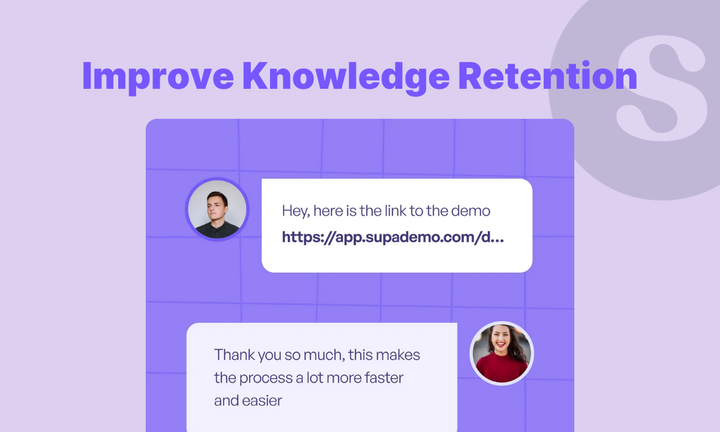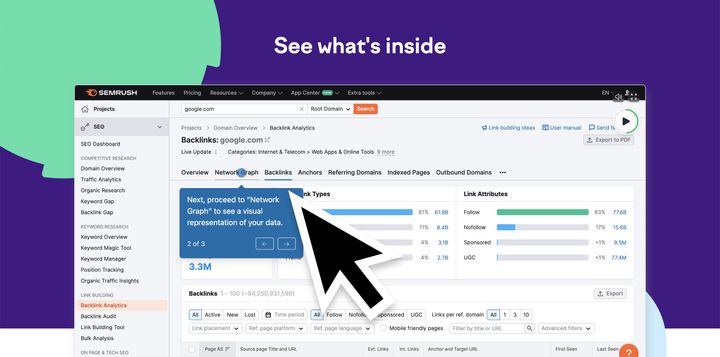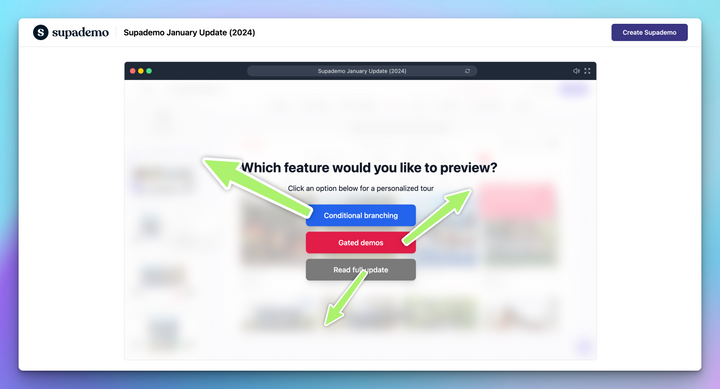Picture this: Your star software engineer just gave two weeks' notice. She's the only person who knows how the legacy integration works, the one who troubleshoots the trickiest customer issues, and mentors half your development team. In two weeks, she'll take with her what experts estimate is worth $2.6 million in institutional knowledge.
This isn't just a hypothetical scenario. Research shows that the average U.S. enterprise loses $4.5 million per year due to poor knowledge retention.
The good news? You can avoid this outcome by investing in systematic knowledge retention strategies.
In this guide, we’ll share 12 proven ways to improve knowledge retention across your team and organization.
- When employees forget what they’ve learned, teams slow down, repeat mistakes, and lose time.
- This guide shares 12 proven strategies to improve knowledge retention—so training sticks, workflows don’t get lost, and your team stays productive.
- From spaced learning to capturing tacit know-how, you’ll learn what works and how Supademo helps you turn knowledge into reusable, trackable, just-in-time guides.
What is knowledge retention, and why does it matter?
Knowledge retention is the ability to absorb and preserve information over time.
For individuals, it means transferring insights from short-term to long-term memory, like remembering how to run a quarterly report or fix a finicky bug you last touched six months ago.
For organizations, it’s the systemized capture of critical know-how: onboarding flows, escalation protocols, customer nuances, everything that keeps the business running smoothly even as people come and go.
When organizations fail to retain knowledge, the consequences are serious:
- New hires struggle to ramp up without a clear context and employee onboarding experience
- Teams repeat mistakes because past lessons aren’t documented or shared
- Training fades fast, with no mechanism to reinforce or revisit key information
What causes poor knowledge retention in organizations?
Before we jump into solutions, let's be honest about what's actually breaking your knowledge retention efforts.

Information overload
Your team is drowning in information across Slack channels, email threads, Google Docs, project tools, and random spreadsheets. When everything feels important, nothing actually is.
People stop searching because finding the right answer takes longer than just asking someone directly.
Turnover and siloed expertise
Your most valuable knowledge sits in individual heads—the senior developer who built your payment system, the customer success manager handling your biggest accounts.
When they leave, years of context, shortcuts, and institutional memory walk out the door with them.
Scattered tools
Knowledge lives everywhere: Confluence docs, Loom videos in random folders, process screenshots in Slack, critical runbooks on someone's desktop.
When information spans multiple platforms, your team wastes time hunting across systems, and new hires don't even know what tools exist.
Passive formats
Static PDFs, outdated SOPs, buried Slack messages. These formats don't engage anyone, can't be updated easily, and fail to stick in memory.
Your team treats documentation like a chore instead of a useful resource that actually helps them work.
12 best ways to improve knowledge retention
If you've spent significant time and resources on employee training programs, employee training tools, and brought in expert facilitators, and watch your team nod enthusiastically during sessions. Then, a week later, it's like the training never happened. You're not alone.
Here's how you retain valuable knowledge and help employees learn better:
1. Use spaced learning
Spaced repetition is one of the most scientifically proven methods for improving long-term knowledge retention. Instead of delivering information in single, intensive sessions, this approach distributes learning across multiple touchpoints over time.
How to implement:
- Schedule follow-up sessions at 1 day, 3 days, 1 week, and 1 month after initial training
- Use the "receive, recall, repeat, retain" framework for structured knowledge reinforcement
- Create automated reminder systems that prompt employees to revisit key concepts at strategic intervals
2. Create microlearning content libraries
Microlearning breaks complex topics into digestible 5-10 minute modules that employees can consume during natural work breaks. This approach combats information overload and fits self-paced learning into busy schedules.
How to implement:
- Build focused modules covering single topics like running reports or troubleshooting specific issues
- Make content mobile-friendly and searchable by role, skill level, and use case
- For new hires, you can create learning paths that connect related microlearning modules for comprehensive skill building
One of the most effective ways to implement this knowledge retention strategy is to use interactive demo tools like Supademo.
3. Promote a knowledge-sharing culture
A knowledge-sharing culture transforms individual expertise into organizational assets by making information exchange a natural part of daily work routines.
How to implement:
- Create internal forums and channels dedicated to topic-specific discussions
- Host regular lunch-and-learns where employees present their expertise to colleagues
- Reward active knowledge contributors with recognition, incentives, or performance metrics
4. Incentivize and gamify learning
Gamification encourages engagement by turning learning into a rewarding experience. Whether through competition, recognition, or progress tracking, it motivates employees to retain and apply new knowledge.
How to implement:
- Tie learning milestones to real-world impact metrics like support ticket resolution time or onboarding speed
- Offer rewards or recognition for completing training modules or contributing to the knowledge base
5. Train on real-world scenarios
Training resonates more when it reflects what people actually do. Scenario-based learning boosts recall by anchoring abstract ideas in familiar situations.
How to implement:
- Design role‑specific walkthroughs using realistic tasks and outcomes tied to daily responsibilities (e.g. sales handoffs, bug triage, QBR prep)
- Enable interactive sandbox environments so team members can safely practice workflows and learn by doing.
Here’s an Ahrefs sandbox demo built with Supademo. A new marketing hire can explore workflows like keyword research or site audits without risking live data.
6. Create a central knowledge hub
When knowledge is easy to find, it's easier to retain. A centralized, organized hub ensures employees aren’t stuck searching across tools or repeating questions.
How to implement:
- Link help docs, SOPs, and FAQs in one place—like Notion, Confluence, or your intranet
- Tag resources by role, topic, or workflow so teams can self-serve answers
- Make the hub part of onboarding and daily processes not just a one-time resource
7. Capture tacit knowledge systematically
Not everything worth knowing is written down. The most valuable insights—how a specific client prefers their reports, or how a team lead troubleshoots a recurring issue—are often learned informally and stored in someone’s head. When that person leaves or changes roles, that knowledge goes with them.
How to implement:
- Ask team members to record walkthroughs of nuanced workflows. Instead of static video, your team can use Supademo to capture exact steps, annotate, highlight key points, and create an interactive training video for better understanding.
- Build knowledge capture into role transitions, project offboarding, and tool migrations
Here's an example workflow captured using Suapdemo:
8. Conduct regular knowledge audits
Knowledge isn’t static; tools change, processes evolve, and what was true six months ago might now be a liability. A regular audit keeps your content clean, up to date, and actually useful.
How to implement:
- Review all knowledge assets like docs, FAQs, and videos on a quarterly or biannual basis and flag outdated, redundant, or unused content for revision or deletion.
- Track employee questions to identify new content that needs to be created
9. Enable peer-to-peer knowledge transfer
Learning doesn’t just come from formal training—it happens in quick Slack messages, impromptu walkthroughs, and casual desk-side coaching. When employees teach each other, they retain more, and so do their peers.
How to implement:
- Pair new hires with experienced mentors who demonstrate processes live or by sharing interactive demos
- Ask team members to record and present one tip, workflow, or demo each week
- Encourage “teach-backs,” where learners explain a process they just learned to someone else

10. AI and contextual recommendations
Even well-documented knowledge is useless if no one can find it. AI-powered systems help by recommending the right resources based on context, surfacing help articles, past conversations, or training content at the exact moment someone needs it. This kind of timely support reinforces learning and reduces the need to memorize everything upfront.
How to implement:
- Use internal search or AI-based recommendations to connect people to relevant knowledge
- Tag resources with common use cases, keywords, and tools
- Embed contextual help directly into the apps employees use daily
11. Conduct mentorship programs
Some knowledge is better absorbed through observation and conversation than through documentation. Mentorship allows new employees to watch how work really gets done, ask questions, and build confidence, while mentors reinforce their own expertise by teaching.
How to implement:
- Set up structured mentorship tracks with clear goals and feedback
- Include live walkthroughs or “day in the life” shadowing sessions during onboarding
- Follow up with teach-back opportunities, where mentees demonstrate what they’ve learned
12. Implement just-in-time learning resources
People retain information best when it’s applied right away. Just-in-time learning delivers knowledge at the moment of need, while someone is already inside the tool, completing a task, or solving a problem. It reduces context switching and reinforces learning in real time.
How to implement:
- Link content to specific actions or triggers (e.g., “stuck on this form? Watch this.”)
- Surface in-app product tours inside platforms your team regularly uses like Salesforce, Jira, or Zendesk—so answers appear right when and where they’re needed.
What are the benefits of investing in knowledge retention?
According to the Ebbinghaus’ forgetting curve, humans tend to halve their memory in days or weeks unless that information is consciously re-reviewed.
In a business context, that means hours of training can go to waste without systems in place to retain and apply that knowledge.

Here’s how knowledge retention drives real impact:
Faster onboarding
Remember your last new hire? How long did it take them to stop asking the same questions over and over? With solid knowledge retention systems, employees who go through structured onboarding reach full productivity 34% faster.
That means less time for your senior staff playing "human Google" and more confidence for new team members to actually contribute instead of just trying to keep up. When you've captured the tribal knowledge and made it accessible, new hires can find answers themselves instead of interrupting someone every twenty minutes.
Reduced training costs
Organizations spend thousands on repeat training sessions, but much of that knowledge disappears without follow-up or documentation.
A centralized knowledge base reduces time spent re-explaining processes and lets employees learn on demand. This cuts dependency on busy subject matter experts and lowers ongoing training expenses.
Operational consistency
Systematic knowledge retention ensures seamless process continuity and quality control. With documented protocols and centralized repositories, organizations prevent disruptions when roles change or employees exit.
Standardized procedures reduce errors, maintain performance benchmarks, and deliver uniform service levels, safeguarding reputation and operational efficiency across teams and locations.
Enhanced innovation
"We replaced our traditional content briefs with 'context libraries' - searchable repositories where every successful campaign includes not just the final assets but also the reasoning behind every creative decision. When launching new campaigns, teams can instantly access why specific headlines worked, which emotional triggers resonated, and what A/B tests revealed.
This approach cut our campaign development time by 60% because teams aren't starting from scratch or repeating failed experiments."
~ Kevin Moore, CMO of WalterWrites.ai
When you preserve institutional wisdom instead of letting it walk out the door, you're giving your team a foundation to build on. They're not starting from scratch every time, they're standing on the shoulders of everyone who came before them. That's how breakthrough ideas happen.
Better customer experience
When your team has quick access to solutions, customer preferences, and troubleshooting steps, they resolve issues faster.
Where does Supademo fit in your knowledge retention strategy?
If you're implementing these knowledge retention strategies to capture critical workflows and improve how your team learns, Supademo helps you put them into practice quickly and effectively.
Start by recording any workflow using Supademo’s Chrome extension. There is no writing or editing required. You can create multiple guided tutorials for each role, tool, or use case, and organize them into a single showcase link for easy access.
Once your content is captured, embed it directly into your team’s existing tools. This includes LMS platforms, knowledge bases, CRMs, or onboarding systems. Supademo fits into the flow of work without changing how your team operates.
You can also track engagement, see what is being used or ignored, and update outdated content instantly. This ensures your knowledge stays current, relevant, and actionable.
Make knowledge easy to capture, easier to remember. Try Supademo today.
FAQs
What is the most effective way to improve knowledge retention in the workplace?
Spaced repetition, microlearning, and just-in-time access to knowledge are among the most effective strategies. Combining these with tools like interactive demos can reinforce learning and reduce dependency on repeated training sessions.
How does knowledge retention impact employee performance?
High knowledge retention leads to faster onboarding, fewer mistakes, and better decision-making. When employees can recall and apply information quickly, productivity increases and team confidence improves.
What tools help with knowledge retention?
Tools like learning management systems (LMS), knowledge bases, and interactive demo platforms like Supademo help capture, organize, and deliver knowledge in formats people remember and reuse.
How often should companies audit their knowledge systems?
Teams should audit their knowledge systems at least once every 6 to 12 months. Regular audits help identify outdated content, close knowledge gaps, and ensure information remains useful and accessible.




